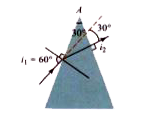A ray of light is incident at 65∘ on one face of a prism of angle of 30∘ and the emergent ray makes 35∘ with the incident ray. The refractive index of the prism is:
1.812
1.414
1.5
1.33
The correct Answer is:A
To find the refractive index of the prism, we can follow these steps:
Step 1: Understand the given information
- The angle of incidence (I) is 65∘.
- The angle of the prism (A) is 30∘.
- The angle of deviation (D) is 35∘.
- We need to find the refractive index (μ) of the prism.
Step 2: Use the relationship between angles
The relationship between the angles can be expressed as:
D=I+E−A
Where:
- D is the angle of deviation,
- I is the angle of incidence,
- E is the angle of emergence,
- A is the angle of the prism.
Step 3: Rearrange the formula to find the angle of emergence (E)
From the equation:
E=D+A−I
Substituting the known values:
E=35∘+30∘−65∘
E=0∘
Step 4: Apply Snell's Law at the first interface
At the first interface (incident ray entering the prism), we apply Snell's law:
μ1sinI=μsinr
Where:
- μ1 is the refractive index of air (approximately 1),
- I is the angle of incidence,
- r is the angle of refraction inside the prism.
Since I=65∘ and μ1=1:
1⋅sin(65∘)=μ⋅sin(r)
Step 5: Determine the angle of refraction (r)
Using the geometry of the prism, we know that:
r+r′=A
Where r′ is the angle of refraction at the second interface. Since E=0∘, we have:
r′=0∘
Thus:
r+0=30∘⟹r=30∘
Step 6: Substitute to find the refractive index (μ)
Now substituting r=30∘ back into Snell's law:
sin(65∘)=μ⋅sin(30∘)
sin(65∘)=μ⋅12
μ=sin(65∘)12=2sin(65∘)
Step 7: Calculate the value of μ
Using a calculator:
sin(65∘)≈0.9063
Thus:
μ≈2⋅0.9063≈1.8126
Final Answer
The refractive index of the prism is approximately 1.812.
---
- The angle of incidence (I) is 65∘.
- The angle of the prism (A) is 30∘.
- The angle of deviation (D) is 35∘.
- We need to find the refractive index (μ) of the prism.
The relationship between the angles can be expressed as:
D=I+E−A
Where:
- D is the angle of deviation,
- I is the angle of incidence,
- E is the angle of emergence,
- A is the angle of the prism.
From the equation:
E=D+A−I
Substituting the known values:
E=35∘+30∘−65∘
E=0∘
At the first interface (incident ray entering the prism), we apply Snell's law:
μ1sinI=μsinr
Where:
- μ1 is the refractive index of air (approximately 1),
- I is the angle of incidence,
- r is the angle of refraction inside the prism.
1⋅sin(65∘)=μ⋅sin(r)
Using the geometry of the prism, we know that:
r+r′=A
Where r′ is the angle of refraction at the second interface. Since E=0∘, we have:
r′=0∘
Thus:
r+0=30∘⟹r=30∘
Now substituting r=30∘ back into Snell's law:
sin(65∘)=μ⋅sin(30∘)
sin(65∘)=μ⋅12
μ=sin(65∘)12=2sin(65∘)
Using a calculator:
sin(65∘)≈0.9063
Thus:
μ≈2⋅0.9063≈1.8126
The refractive index of the prism is approximately 1.812.
Similar Questions
A Ray of light is incident at an angle 60° on one face of a prism which has protecting angle of 30°. The emerging ray deviates through 30° from incident light. The refractive index of material of prism is
View SolutionA ray of light is incident at an angle of 60∘ on one face of a prism which has refracting angle of 30∘ . The ray emerging out of the prism makes an angle of 30∘ with the incident ray. If the refractive index of the material of the prism is μ=√a , find the value of a .
View Solution
Knowledge Check
- Question 1 - Select One
A ray of light is incident at 60∘ on one face of a prism of angle 30∘ and the emergent ray makes 30∘ with the incident ray. The refractive index of the prism is
A1.732B1.414C1.5D1.33 - Question 2 - Select One
A ray of light is incident at an angle of 60∘ on one face of a prism of angle 30∘. They ray emerges normally from the other face of the prism. The refractive index of the prism material is
A√2B√3C2D3 - Question 3 - Select One
A ray of light is incident at an angle of 60∘ on one face of a prism of angle 30∘. The ray emerging out of the prism makes an angle of 30∘ with the incident ray. The emergent ray is
A0∘B90∘C30∘D45∘
A ray of light is incident at an angle of 60° on one face of a 30∘) prism. The emergent ray from the prism makes an angle of 30∘ with the incident ray. Show that the emergent ray is normal to the surface from which it emerges. Calculate the refractive index of the material of the prism.
 View Solution
View SolutionA ray of light is incident at an angle of 60∘ on one face of a prism of angle 30∘. The ray emerging out of the prism makes an angle of 30∘ with the incident ray. The emergent ray is
View SolutionA ray of light is incident at an angle of 60∘ on one face of a 30∘ prism . The emergent ray from the prism makes an angle of 30∘ with the incident ray. The angle of emergence and refractive index of the material of the prism are-
View SolutionA ray of light is incident at an angle of 50∘ on one face of an equilateral prism . What is the angle ,which the emergent ray makes with the second face of the prism , if the deviation produced by the prism is 42∘ ?
View SolutionA ray of light is incident normally on one of the refracting surfaces of a prism of refracting angle A,. The emergent ray grazes the other refracting surface. Find the refractive index of the material ofprism.
View Solution

